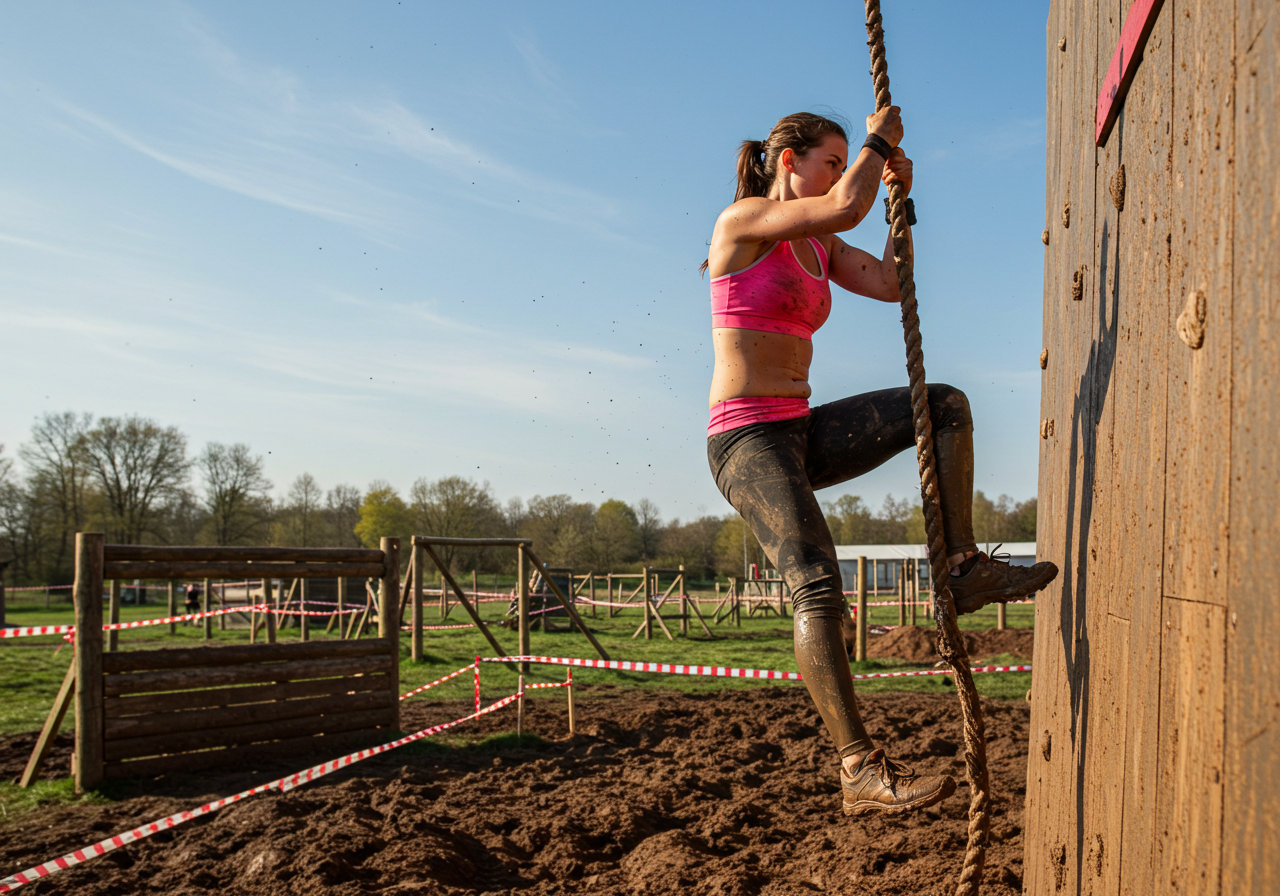
Strength is key when it comes to tackling those tough obstacles. Incorporate bodyweight exercises like push-ups, squats, and planks into your training routine. These movements will help you build the strength necessary for climbing, crawling, and holding onto ropes. The stronger you get, the easier those obstacles will feel.
A big part of obstacle courses is agility, which is why it’s important to include activities like yoga or dance in your training. These will improve your coordination and flexibility, helping you avoid injury while navigating the course. Think of agility as your superpower—being able to move quickly and efficiently over different types of terrain.
To prepare for the real thing, simulate an obstacle course in your training. Whether it’s finding a local obstacle course or setting up one in your backyard, recreating the race environment will give you a chance to practice everything from crawling to climbing to balancing. This hands-on practice will not only prepare you physically but also mentally for race day.
Finally, remember to mix in rest and recovery. Just like a phone needs to recharge, so does your body. So, listen to it! If you feel sore, take a breather or do some light stretching. By following these steps, you’ll be well on your way to mastering How to Train for Obstacle Course Races? and becoming a true obstacle course champion!
Conquer the Course: Essential Training Tips for Aspiring Obstacle Race Warriors
When it comes to obstacle course racing, a well-rounded training plan is key. It’s not just about running long distances; it’s about mixing different types of workouts to build endurance and strength. Think of your training like crafting the perfect smoothie—combine running, strength exercises, and flexibility work to create a balanced routine. By training in multiple areas, you’ll develop the endurance to power through obstacles and the explosive strength to conquer them with confidence.
One of the best ways to prepare is by practicing the obstacles themselves. If you can find a local obstacle course, take advantage of it. Familiarizing yourself with the challenges—whether it’s climbing walls, crawling through mud, or jumping over fire pits—will help you develop a strategy and build confidence. The more you practice, the easier it will become, and soon enough, you’ll feel ready to tackle anything that comes your way.

Lastly, remember to listen to your body. Training for an obstacle race is a journey, and knowing when to push yourself and when to rest is crucial. Recovery is an essential part of your training plan. Taking rest days allows your body to recharge and recover, ensuring you’re at your best when it’s time to race. A well-rested body will help you perform at your peak during the event.
Now, it’s time to lace up those shoes and get started! The obstacle course awaits, and with the right preparation and mindset, you’re more than ready to take it on. Let the excitement of the race motivate you as you train and prepare for the finish line!
From Couch to Course: Your Ultimate Guide to Obstacle Race Training
Think of your body like a reliable vehicle. If you want to go from zero to sixty, you can’t expect peak performance without a little maintenance along the way! Begin with simple workouts, like jogging or brisk walking. Even dedicating just 20 minutes a day will help kickstart your fitness journey. To build strength gradually, add in bodyweight exercises like push-ups and squats. These are essential for building your foundation, much like tuning up a car’s engine for better performance.
Next, it’s time to embrace a bit of adventure! Find a local park or gym with obstacles, or set up your own mini circuit at home using everyday items. A bench can become your box jump platform, and a sturdy fence is perfect for practicing climbing. Let your imagination run wild and turn each exercise into a playful challenge. Training doesn’t have to feel like a chore—it can be fun, too!
Flexibility should also be part of your routine. Incorporating yoga or simple stretching exercises will help keep your body limber and reduce the risk of injuries. Think of it as oiling the engine to ensure smooth movement during your workouts. And remember, hydration is key! Keep your water bottle close by, as staying hydrated is essential for fueling your body and maintaining energy levels during your training.
With these foundational steps in place, you’ll be well on your way to conquering your first obstacle course race. Stay consistent, have fun, and watch as your strength and agility grow with each training session!
Mastering Mud: Key Exercises to Dominate Obstacle Course Races
When asking How to Train for Obstacle Course Races?, lunges should be one of your go-to exercises. Not only do they build leg strength, but they also improve your balance. Navigating through slippery mud requires stability, and lunges mimic the movement needed to stay upright. Add lateral lunges to your routine to train your legs for the side-to-side motions you’ll encounter during obstacles. It’s like preparing for a dance-off with the mud, making sure you’re nimble and balanced!
Burpees are another essential move to incorporate into your training. These full-body exercises are perfect for building strength and explosiveness. The dynamic jump at the end of each burpee simulates the power you’ll need to leap over muddy pits and obstacles. Think of it as your personal launching pad, preparing your body for the high-intensity effort required on race day.
Core strength is often overlooked but is crucial when it comes to obstacle races. Plank variations are your secret weapon for stabilizing your movements through tough terrain. A solid plank helps prevent wobbling and keeps your body aligned as you slog through thick mud. To take it a step further, try alternating arm raises or side planks to engage your entire core—your body’s anchor as you power through the race.
Don’t forget about explosive power! The classic box jump is perfect for training your ability to leap over obstacles or power through steep inclines. This exercise is all about jumping high and landing safely, simulating the type of force you’ll need when faced with obstacles buried in sludge. Picture yourself propelling off the ground and leaving the mud behind as you soar with ease.
These exercises are essential when learning How to Train for Obstacle Course Races? Each one builds strength, power, and agility that will help you conquer the toughest obstacle courses. So lace up your shoes and get ready to dominate the mud!

Beyond the Finish Line: The Mental Strategies Behind Obstacle Race Success
Running an obstacle race is like playing chess with yourself—each obstacle presents a decision point, and how you approach it is key to your success. When you ask How to Train for Obstacle Course Races?, it’s not just about physical preparation; mental strategies are equally important. Top racers often use visualization techniques to mentally prepare for the challenges ahead. They picture themselves effortlessly climbing walls and charging through muddy pits long before race day. This mindset shift turns what could be a daunting obstacle into just another series of small, manageable steps, transforming fear into excitement and motivation.
Another powerful mental strategy is self-talk. If you’ve ever caught yourself thinking, “I can’t do this,” you’re not alone. But negative self-talk can hold you back, both mentally and physically. Elite racers know how to flip the script. They turn their inner dialogue into powerful affirmations. Simple mantras like “I’m strong” or “I’ve got this” serve as fuel for the mind, helping them power through moments of doubt and fatigue. Every positive thought builds momentum, propelling them forward even when the race feels overwhelming.
By incorporating these mental strategies into your training, you can create a powerful mindset that will carry you through the toughest obstacles. Whether it’s visualizing success or boosting your confidence with positive self-talk, the mental side of How to Train for Obstacle Course Races? is just as crucial as the physical preparation. With the right mindset, you can conquer any challenge that comes your way!
Building Strength and Stamina: The Perfect Obstacle Race Training Regimen
So, what’s the secret to crafting the perfect obstacle race training regimen? It begins with a well-rounded balance of strength and stamina workouts. Strength training lays the foundation, much like the base of a house—without it, everything else could fall apart. Exercises like squats, deadlifts, and pull-ups are essential. These moves not only sculpt your muscles but also enhance grip and core strength, which are crucial for tackling obstacles like rope climbs and monkey bars.
Next, let’s focus on stamina. Long-distance runs and high-intensity interval training (HIIT) should be your best friends. Imagine sprinting through the woods, feeling light yet powerful—just like a gazelle. Sprint intervals are perfect for mimicking those explosive bursts of energy needed during the race. In addition, cross-training activities like cycling or swimming keep things exciting and help improve overall endurance while adding variety to your workouts.
Agility plays a huge role, too. Think of agility drills as dancing your way through obstacles. Quick feet and nimble movements can make all the difference when it comes to navigating tight spots. Ladder drills or cone exercises are great ways to enhance your footwork and reaction time.
Lastly, don’t forget the importance of recovery. Just like a well-written story needs a solid conclusion, your training regimen needs rest days to let your body recover, rebuild, and grow stronger. Rest is an essential part of the process, allowing your muscles to repair and preparing you for your next training session.
By trusting the process and incorporating strength, stamina, agility, and recovery into your regimen, you’ll transform your body into an unstoppable powerhouse, ready to take on any obstacle in your path. So lace up those shoes and get training—it’s time to become the obstacle course warrior you’ve always wanted to be!

Tackling Terrain: How to Prepare for the Unexpected in Obstacle Racing
When preparing for obstacle racing, How to Train for Obstacle Course Races? The answer isn’t as simple as following a one-size-fits-all plan. Just like a chef needs specific skills to prepare a gourmet meal, you need to tailor your training to the obstacles you’ll face. Make sure to practice on varying terrains—hills, sand, gravel, and even parkour-style walls. These challenges simulate the unexpected twists and turns you’ll encounter during the race. Think of it like transforming your body into a versatile tool, ready for anything the course throws at you.
Next, let’s discuss gear. You wouldn’t climb a mountain in flip-flops, right? Invest in quality footwear designed for grip on slippery surfaces and rough trails. Your shoes are your first line of defense when navigating tough terrain. And don’t forget that your attitude is just as important as your gear! Treat every obstacle with the mindset of an explorer—view the unknown as an opportunity to grow, not as a roadblock.
Visualization is another key strategy in preparing for the unexpected. Close your eyes and picture yourself overcoming every surprise that might come your way during the race—slipping through mud, scaling a wall, or crawling under barbed wire. This mental rehearsal doesn’t just prepare you for the challenges; it conditions your mind to act swiftly when the real race begins.
So, are you ready to embrace the unexpected? Challenge yourself to step outside your comfort zone, and watch as you rise to meet each obstacle with confidence and strength. With the right training, gear, and mindset, you’ll be prepared for whatever the course has in store for you.
Obstacle Race Prep: Nutrition Tips to Fuel Your Adventure

Next, let’s talk about carbs, your muscle’s best friend. Complex carbs like oats, brown rice, and sweet potatoes are your go-to foods before the race. Think of them as your energy reservoir—loading up on these will fuel you for those long, challenging stretches of the course. You wouldn’t drive a car on empty, so don’t let your body run low on fuel.
Protein is another essential part of your nutrition plan. Foods like chicken, fish, eggs, or plant-based options like beans and lentils help with muscle recovery after intense training sessions. Healthy fats from sources like avocados or nuts can give you that extra boost of energy and keep you feeling full for longer.
And don’t forget about snacks! Energy bars, dried fruits, and other quick, nutritious options are great for replenishing energy during or before the race. Pack them in your race bag for a quick refuel when you need it most. Remember, every runner’s nutrition needs are different, so take the time to experiment during your training to see what works best for you.
With the right hydration, carbs, protein, and snacks, you’ll be ready to tackle the obstacles ahead. Fuel your body properly, and you’ll be set to crush the course and enjoy the adventure that awaits!




